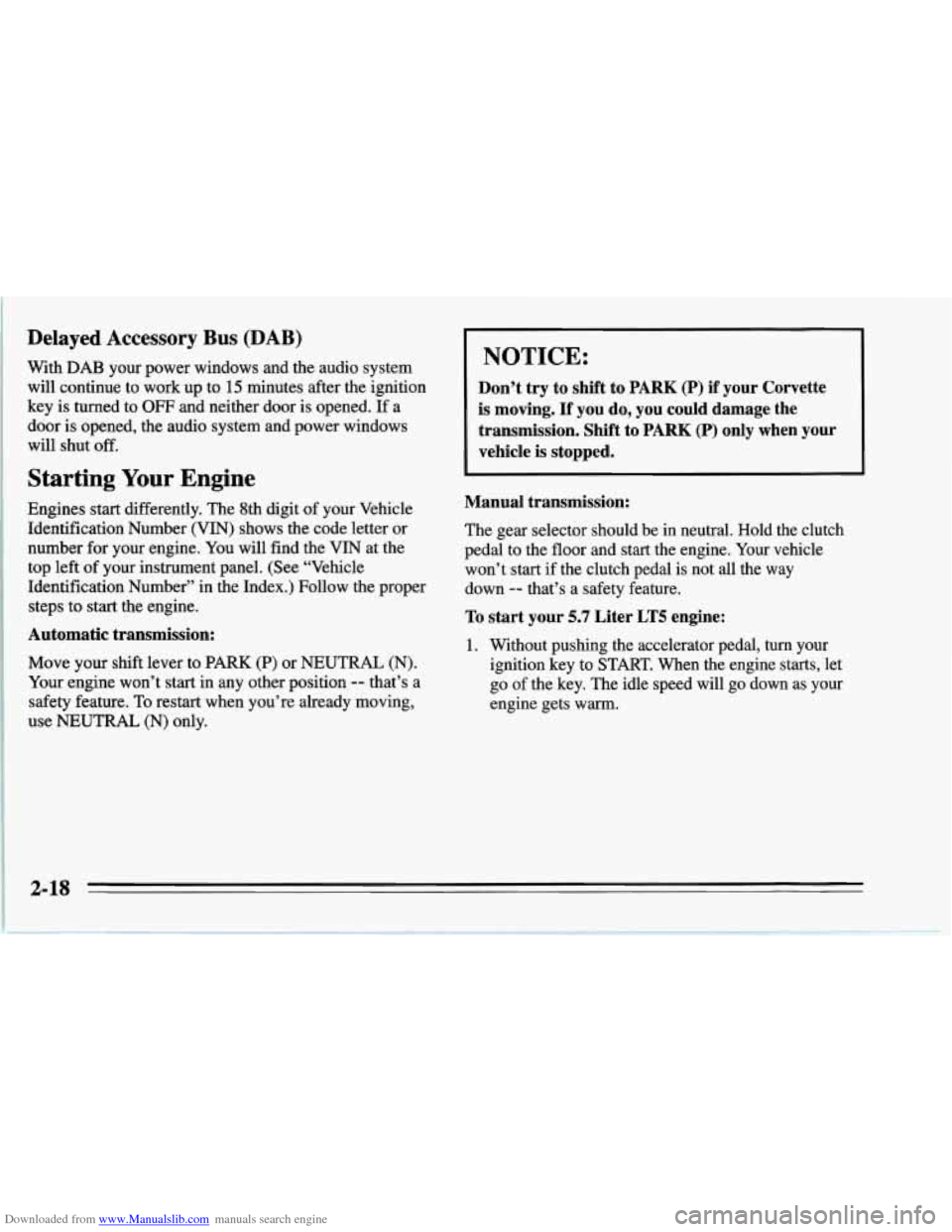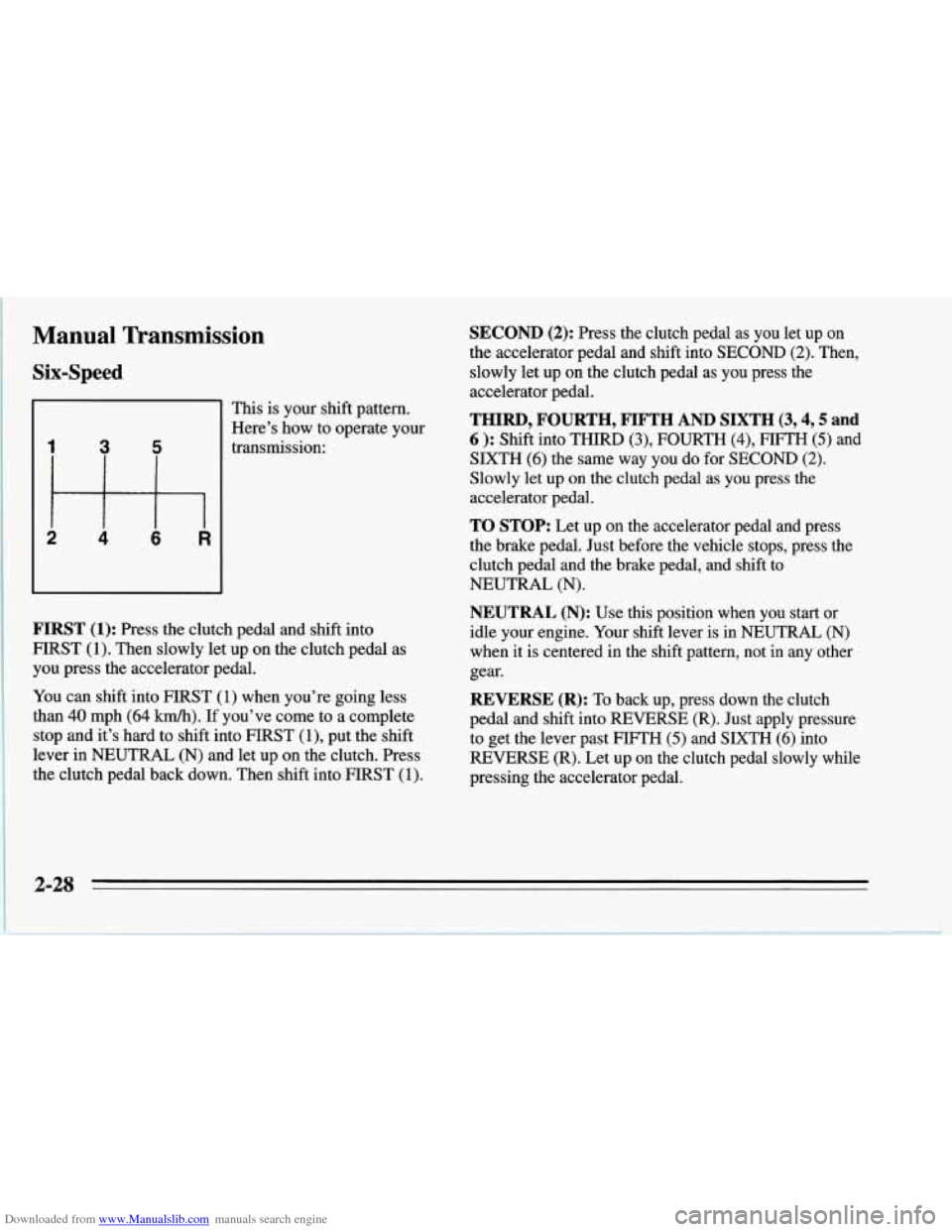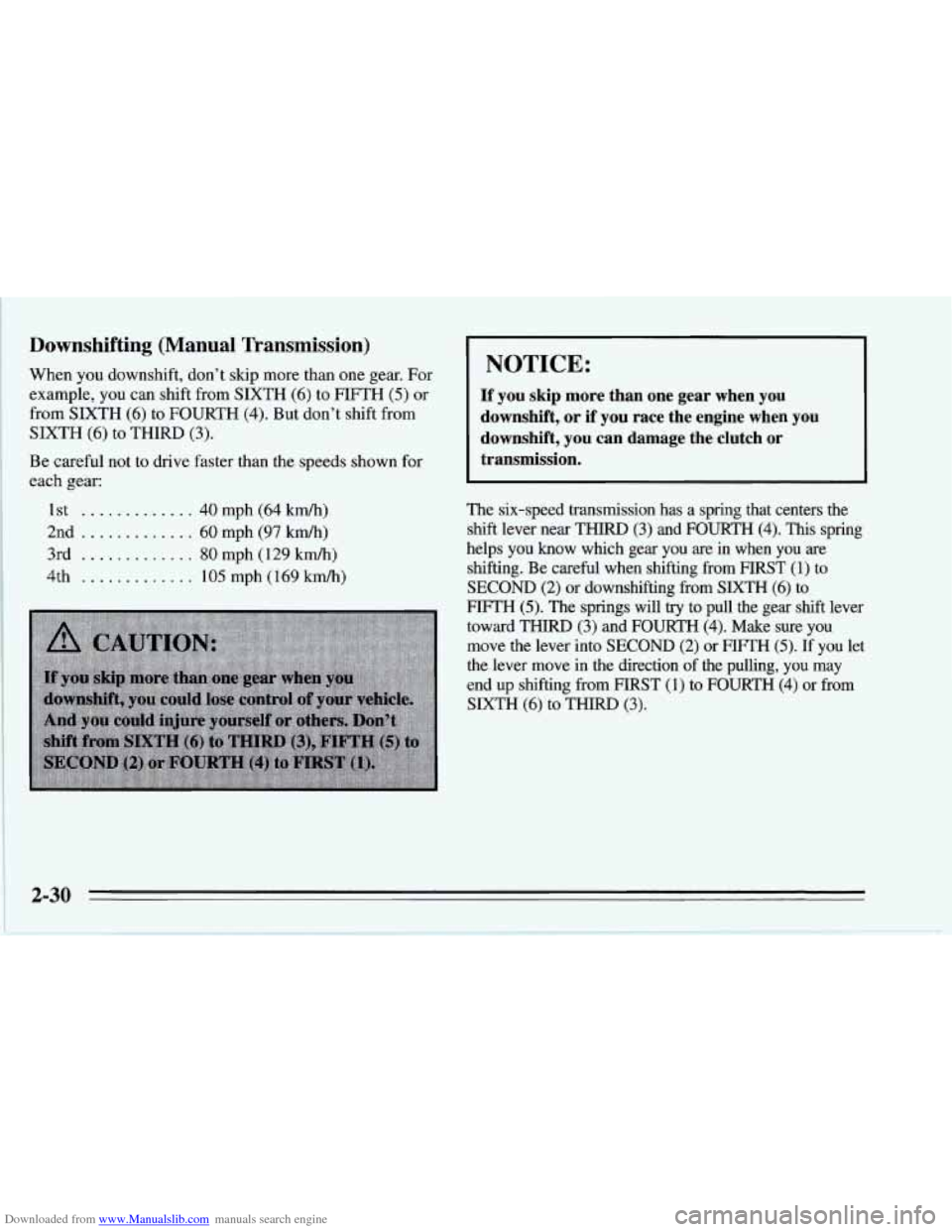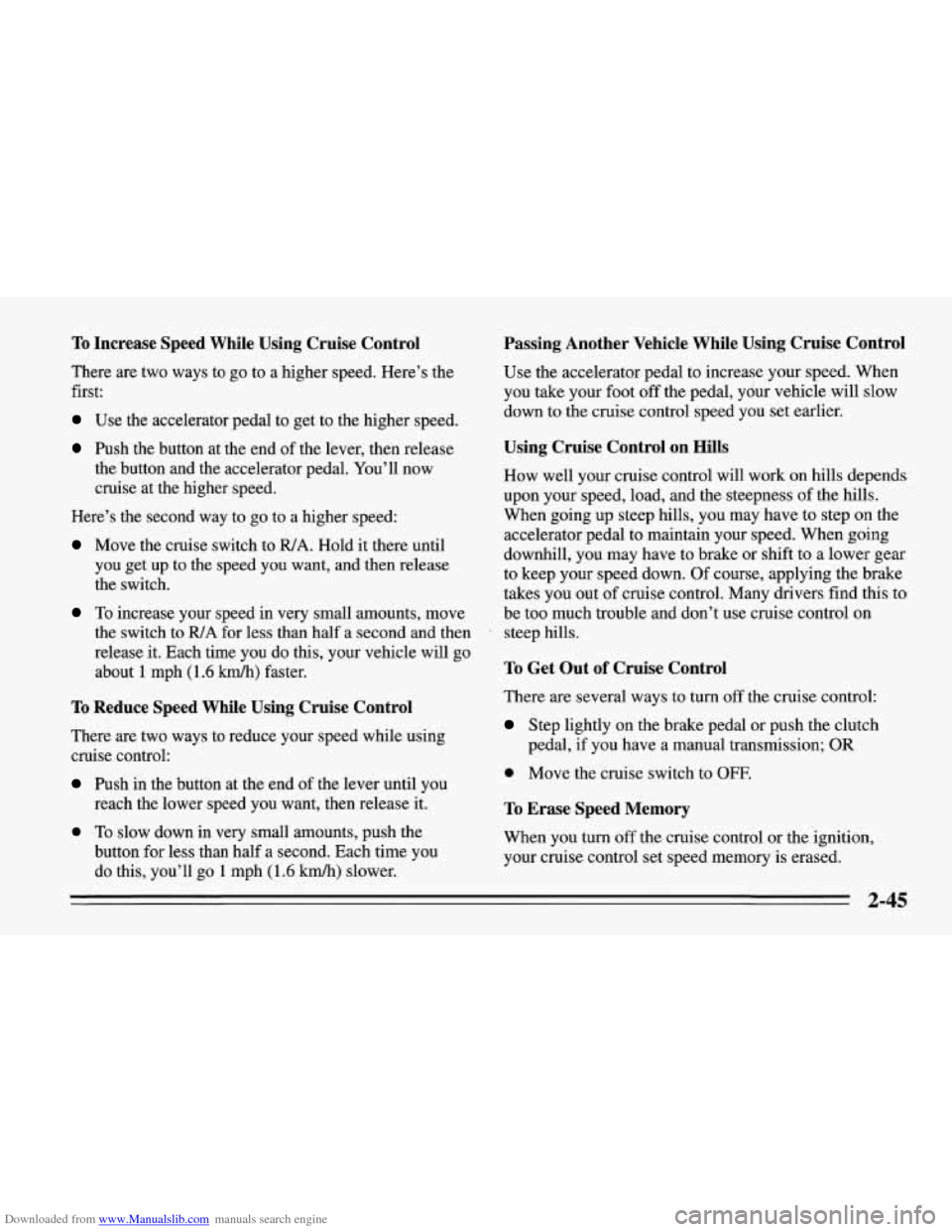Page 61 of 386

Downloaded from www.Manualslib.com manuals search engine Delayed Accessory Bus (DAB)
With DAB your power windows and the audio system
will continue to work up to 15 minutes after the ignition
key
is turned to OFF and neither door is opened. If a
door is opened, the audio system and power windows
will shut
off.
Starting Your Engine
Engines start differently. The 8th digit of your Vehicle
Identification Number
(VIN) shows the code letter or
number for your engine. You will find the
VIN at the
top left of your instrument panel. (See “Vehicle
Identification Number” in the Index.) Follow the proper
steps to
start the engine.
Automatic transmission:
Move your shift lever to PARK (P) or NEUTRAL (N).
Your engine won’t start in any other position
-- that’s a
safety feature. To restart when you’re already moving,
use
NEUTRAL (N) only.
NOTICE:
Don’t try to shift to PARK (P) if your Corvette
is moving.
If you do, you could damage the
transmission. Shift
to PARK (P) only when your
vehicle is stopped.
Manual transmission:
The gear selector should be in neutral. Hold the clutch
pedal to the floor and start the engine. Your vehicle
won’t start if the clutch pedal is not all the way
down
-- that’s a safety feature.
To start your 5.7 Liter LT5 engine:
1. Without pushing the accelerator pedal, turn your
ignition key to START. When the engine starts, let
go of the key. The idle speed will go down as your
engine gets warm.
Page 71 of 386

Downloaded from www.Manualslib.com manuals search engine Manual Transmission
Six-Speed
I This is your shift pattern.
Here’s how to operate your
transmission:
1
ttFl
2 4 6 .R
FIRST (1): Press the clutch pedal and shift into
FIRST (1). Then slowly let up on the clutch pedal as
you press the accelerator pedal.
You can shift into FIRST (1) when you’re going less
than
40 mph (64 km/h). If you’ve come to a complete
stop and it’s hard to shift into FIRST
(1), put the shift
lever in NEUTRAL (N) and let up on the clutch. Press
the clutch pedal back down. Then shift into FIRST
(1).
SECOND (2): Press the clutch pedal as you let up on
the accelerator pedal and shift into SECOND
(2). Then,
slowly let up on the clutch pedal as you press the
accelerator pedal.
THIRD, FOURTH, FIFTH AND SIXTH (3,4,5 and
6 ): Shift into THIRD (3), FOURTH (4), FIFTH (5) and
SIXTH
(6) the same way you do for SECOND (2).
Slowly let up on the clutch pedal as you press the
accelerator pedal.
TO STOP: Let up on the accelerator pedal and press
the brake pedal. Just before the vehicle stops, press the
clutch pedal and the brake pedal, and shift to
NEUTRAL
(N).
NEUTRAL (N): Use this position when you start or
idle your engine. Your shift lever is in NEUTRAL (N)
when it is centered in the shift pattern, not in any other
gear.
REVERSE (R): To back up, press down the clutch
pedal and shift into REVERSE (R). Just apply pressure
to get the lever past FIFTH
(5) and SIXTH (6) into
REVERSE
(R). Let up on the clutch pedal slowly while
pressing the accelerator pedal.
2-28
Page 73 of 386

Downloaded from www.Manualslib.com manuals search engine Downshifting (Manual Transmission)
When you downshift, don’t skip more than one gear. For
example, you can shift from SIXTH (6) to FIFTH (5) or
from SIXTH (6) to FOURTH
(4). But don’t shift from
SIXTH
(6) to THIRD (3).
Be careful not to drive faster than the speeds shown for
each gear:
1st
......
2nd .........
3rd . . . .
4th . .
. . 40 mph (64 km/h)
. . 60 mph (97 km/h)
. . 80 mph (129 km/h)
. . 105 mph (169M)
NOTICE:
If you skip more than one gear when you
downshift, or if you race the engine when you
downshift, you can damage the clutch
or
transmission.
The six-speed transmission has a spring that centers the
shift lever near THIRD
(3) and FOURTH (4). This spring
helps you know which gear you
are in when you are
shifting. Be careful when shifting from FIRST (1) to
SECOND (2) or downshifting from SIXTH (6) to
FIFTH (5). The springs will try to pull the gear shift lever
toward
THIRD (3) and FOURTH (4). Make sure you
move the lever into SECOND (2)
or FIFTH (5). If you let
the lever move in the direction of the pulling, you may
end
up shifting from FIRST (1) to FOURTH (4) or from
SIXTH (6) to THIRD (3).
Page 86 of 386
Downloaded from www.Manualslib.com manuals search engine Cruise Control
With cruise control, you can
maintain a speed of about
25 mph (40 km/h) or more
without keeping your foot
on the accelerator.
This can
really help on long trips. Cruise control does not
work at speeds below about
25 mph (40 km/h).
When you apply your brakes or push the clutch pedal
the cruise control shuts off.
If your vehicle is in cruise control when the
ASR system
begins to limit wheel spin, the cruise control will
automatically disengage. (See
"ASR System'' in the
Index.) When road conditions allow you to safely use it
again, you may turn the cruise control back on.
2-43
Page 87 of 386
Downloaded from www.Manualslib.com manuals search engine To Set Cruise Control To Resume a Set Speed
1. Turn the cruise control on.
2. Get up to the speed you want.
3. Push in the set button
at the end
of the lever
and release
it.
4. Take your foot off the accelerator pedal. Suppose you set your cruise control
at a desired speed
and then you apply the brake or clutch pedal.
This, of
course, shuts off the cruise control. But you don’t need
to reset it.
Once you’re going about
25 mph (40 km/h) or more,
you can move the cruise
control switch to IUA
(Resume/Accelerate) for
about half a second.
You’ll go right back up
to your chosen speed and stay
there.
2-44
Page 88 of 386

Downloaded from www.Manualslib.com manuals search engine To Increase Speed While Using Cruise Control
There are two ways to go to a higher speed. Here’s the
first:
Use the accelerator pedal to get to the higher speed.
Push the button at the end of the lever, then release
the button and the accelerator pedal. You’ll now
cruise at the higher speed.
Here’s the second way to go to a higher speed:
Move the cruise switch to R/A. Hold it there until
you get up to the speed you want,
and then release
the switch.
To increase your speed in very small amounts, move
the switch to
R/A for less than half a second and then
release it. Each time you do this, your vehicle will
go
about 1 mph (1.6 km/h) faster.
To Reduce Speed While Using Cruise Control
There are two ways to reduce your speed while using
cruise control:
Push in the button at the end of the lever until you
reach the lower speed you want, then release it.
0 To slow down in very small amounts, push the
button for less than half a second. Each time you
do this, you’ll go 1 mph (1.6 km/h) slower.
Passing Another Vehicle While Using Cruise Control
Use the accelerator pedal to increase your speed. When
you take your foot off the pedal, your vehicle will slow
down to the cruise control speed you set earlier.
Using Cruise Control on Hills
How well your cruise control will work on hills depends
upon your speed, load, and the steepness
of the hills.
When going up steep hills, you may have to step on the
accelerator pedal to maintain your speed. When going
downhill, you may have to brake or shift to a lower gear
to keep your speed down. Of course, applying the brake
takes you out of cruise control. Many drivers find ths to
be too much trouble and don’t use cruise control on
steep hills.
To Get Out of Cruise Control
There are several ways to turn off the cruise control:
Step lightly on the brake pedal or push the clutch
pedal, if you have a manual transmission;
OR
0 Move the cruise switch to OFF,
To Erase Speed Memory
When you turn off the cruise control or the ignition,
your cruise control set speed memory is erased.
2-45
Page 244 of 386
Downloaded from www.Manualslib.com manuals search engine You’ll see the following when you open the hood with
the
LTl engine:
1.
2.
3.
4.
5.
6.
7.
8.
9.
10.
11.
12.
Hydraulic Clutch Fluid Reservoir (if equipped)
Brake Fluid Reservoir
Battery
Electric Engine Fan
Air Cleaner
Coolant Recovery Tank Power Steering Fluid Reservoir
Engine Oil Fill Cap
Engine Oil Dipstick Windshield Washer Fluid Reservoir
Coolant High
Fill Reservoir
Automatic Transmission Dipstick (if equipped)
6-9
Page 245 of 386
Downloaded from www.Manualslib.com manuals search engine Before closing the hood, be sure all the filler caps are
on.
You’ll see the following when you open the hood with
the
LT5 engine:
1. Hydraulic Clutch Fluid Reservoir
2. Brake Fluid Reservoir
3. Battery
4. Electric Engine Fan
6-10